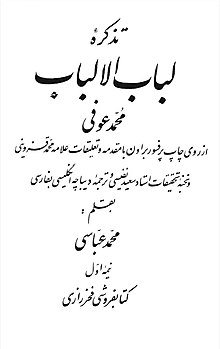
Lubab ul-Albab (Persian: لباب الالباب, variously translated as "Quintessence of Hearts", "The best selection", or "The select of the select") is a renowned anthology written by Muhammad Aufi in eastern Persia. It was reportedly completed in 1221.[1]
It is considered as the oldest extant biographical work in Persian literature and the most important collection of biographies of Persian poets. It is essentially a history of literature, or more accurately, a collection of biographies of poets written in a highly ornate style. Although Aufi was not a distinguished stylist, the significance of both the Lubab ul-Albab and the Jawami ul-Hikayat lies in their practical value.[2] This book includes 27 biographies of the poets who lived in the same era.
It serves as a key resource for studying the poetry of the Seljuq period.[1] Aufi begins by acknowledging the contributions of royal figures who wrote poetry, listing 27 rulers from the late 10th to the 12th century, whose works constitute about 6% of the anthology. Following the kings, the anthology includes works by viziers (14%), religious scholars (ulama, 38%), and a substantial group of court poets, who make up 62% of the content.[1]
- ^ a b c Durand-Guédy 2024, p. 392.
- ^ The Cambridge History of Iran, Ed. J. A. Boyle, (Cambridge University Press, 1968), 616.